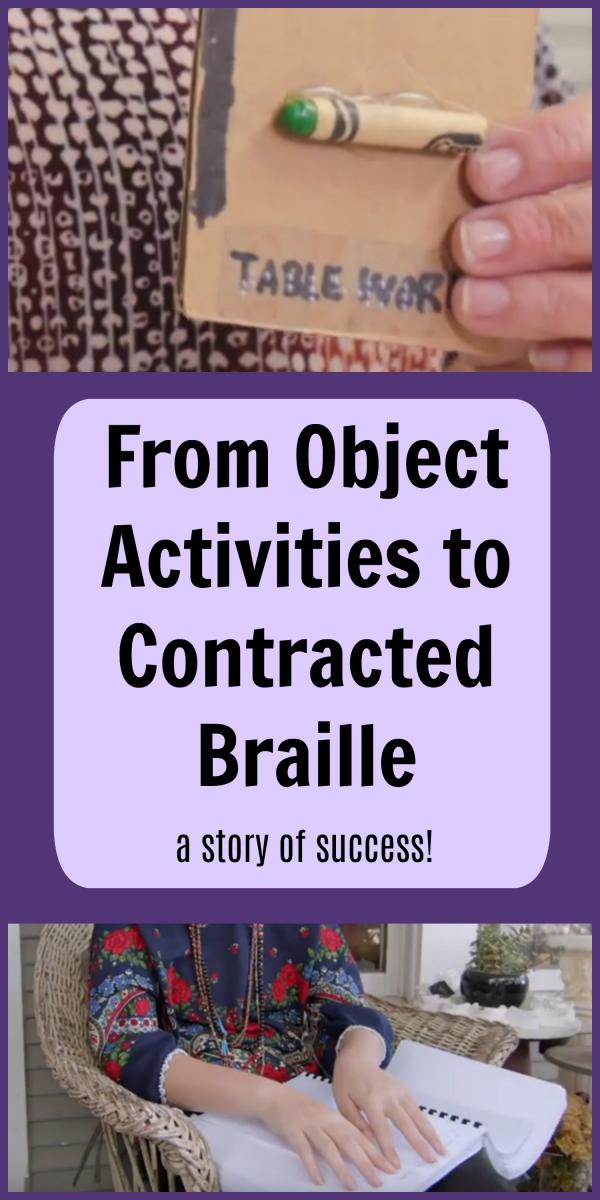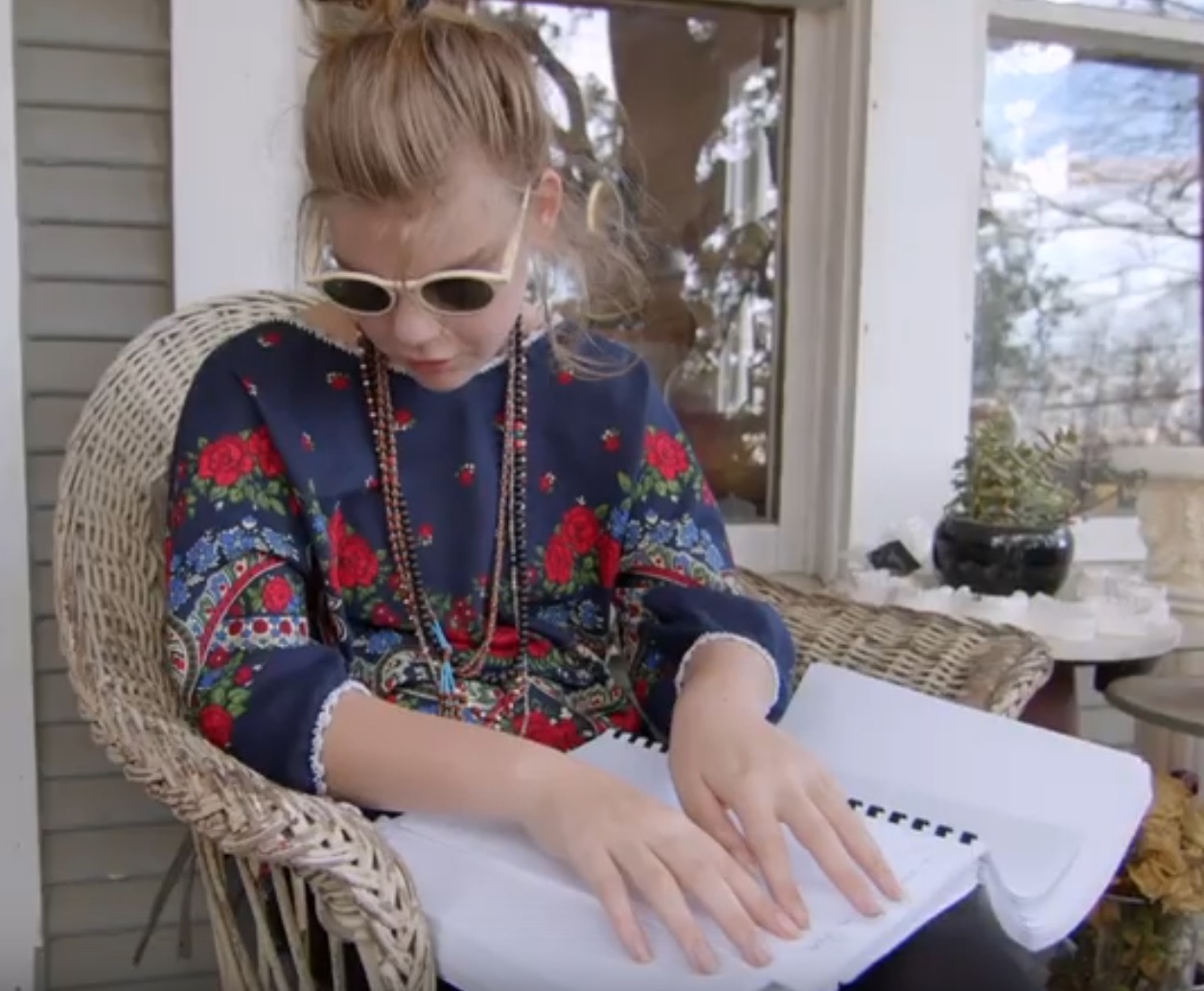
The Legend of Holly and Zelda: From Object Activities to Contracted Braille
This documentary video tells the story of a girl who is blind with behavioral challenges who masters the braille code, by moving from object and auditory activities to contracted braille.
By Debra Leff
This documentary feature from Region 13 Education Service Center in Austin, Texas tells the story of Zelda, a student at Lively Middle School in Austin Independent School District. This is a look inside the amazing world of Zelda, a child who is blind and has behavioral challenges, and Holly, her committed Teacher of the Visually Impaired (TVI). We meet Zelda’s family and Holly shares how she was able to unlock Zelda’s brilliance.
Transcript
Holly (TVI): When I met Zelda, I knew that she had this spark. She just wanted to learn about the world and she told me from the very beginning, “Ms. Holly, I wanna be able to read a braille book.” So I was trying to figure out a way to integrate the auditory and the braille in order to give her that literacy that she needed. “The weather wolf says it’s smoggy, so it means… So it means the weather said changes, weather changes… We might have rain chances coming up.”
Her Parents Share the Story of Her Early Life
Evan and Gail (Parents): Zelda is silly, so funny. She never gives up. She’s very intuitive, and responds well to people. She’s magical. My name’s Evan Voyles, this is my wife Gail Chovan. We are the parents of Zelda and Creed Voyles. At a very early age, I knew that Zelda would not see and she would have to learn braille. And the great irony for us is that we’re visual people, and we think visually. I mean in our business, our entire lives revolve around that and so to have this particular circumstance was a challenge for us, and probably a challenge for Zelda because she didn’t know the difference we did. Zelda was the first to walk, she was the first to talk of the twins we have, so she’s the pioneer.
When your child is born blind, you go through all of these stages and of course then it’s just maintenance when they’re little. Like oh my god, what do we do, they gotta you know, grow, and potty train, and do all these things, and then they start getting into their academic life. We immediately started her being exposed to braille by tagging things in our home, and getting her braille books, word books for babies, but it wasn’t until Holly came into her education and our lives that Zelda really caught on, and now it’s just exploding. It’s one thing to put braille labels on your house, but to teach someone to read that with their fingers is beyond our capability.
Starting with a Calendar System
TVI Holly continues: When Zelda was in first grade, we started with just a simple calendar system to build that trust in and develop those routines. So important for her to anticipate what was going to happen next. So she would be able to work through a lesson and if we did that slowly, with just one activity at a time and then a quick break. She had a little, simple object calendar system that we used and we slowly lengthened the time between those activities.
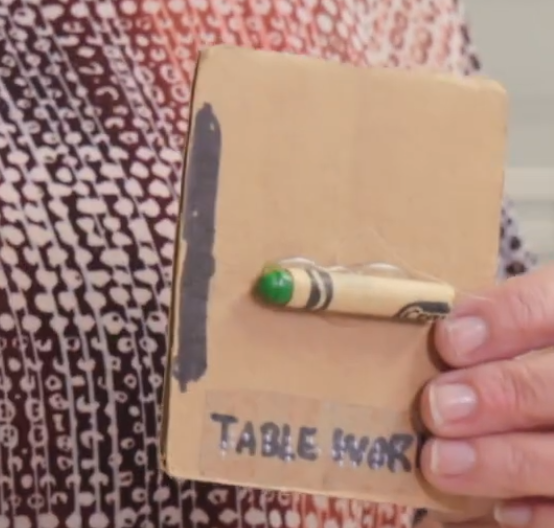
I think that’s when we saw how Zelda was reacting to Holly. So we kind of stepped back and said, “Okay, we’re gonna give this part of the life to her.” And then we’ve entrusted Holly with that part of her life. And Sarah Hyzy, and all of– Caleb, and Emily, and all of the people now at Fullmore.
Sara, Orientation and Mobility Specialist: When I first started working with Zelda, I had to start to start building things up and start preempting her for things that happen before they actually happen. So weeks or months before we travel to a new environment, or we try something different, we have to talk about it.
The Importance of Music
Gail (mother): She loved auditory, she loved music. Holly, she said, “What do we do with Zelda?” I’m like, well if we can get her music. Evan plays the guitar, and sings, and has always done that with the kids. From an early age, we would play music for them to go to sleep by. And I sometimes, even now, we’re standing in line, and she’s freaking out, I will just hand her my iPhone and say, “What would you like to hear?” I think it’s a calming influence to her, it’s her…Kind of her touchstone, her grounding that helps us a lot.
Behavioral Challenges Early On
Holly (TVI): I would just do trial and error, I find things, I pair them with YouTube videos, little songs. They had to be fun, and many times I brought things in that weren’t fun and she would get frustrated and throw them, or just refuse to do them. So when I found something that worked, I just built on it. I would just make it more and more challenging, and then we moved onto blend words, and then we eventually moved on to reading stories that way. So I just pulled that auditory in to get her to gain that attention that I needed, and for her to learn and that opened up a whole ‘nother window for her.
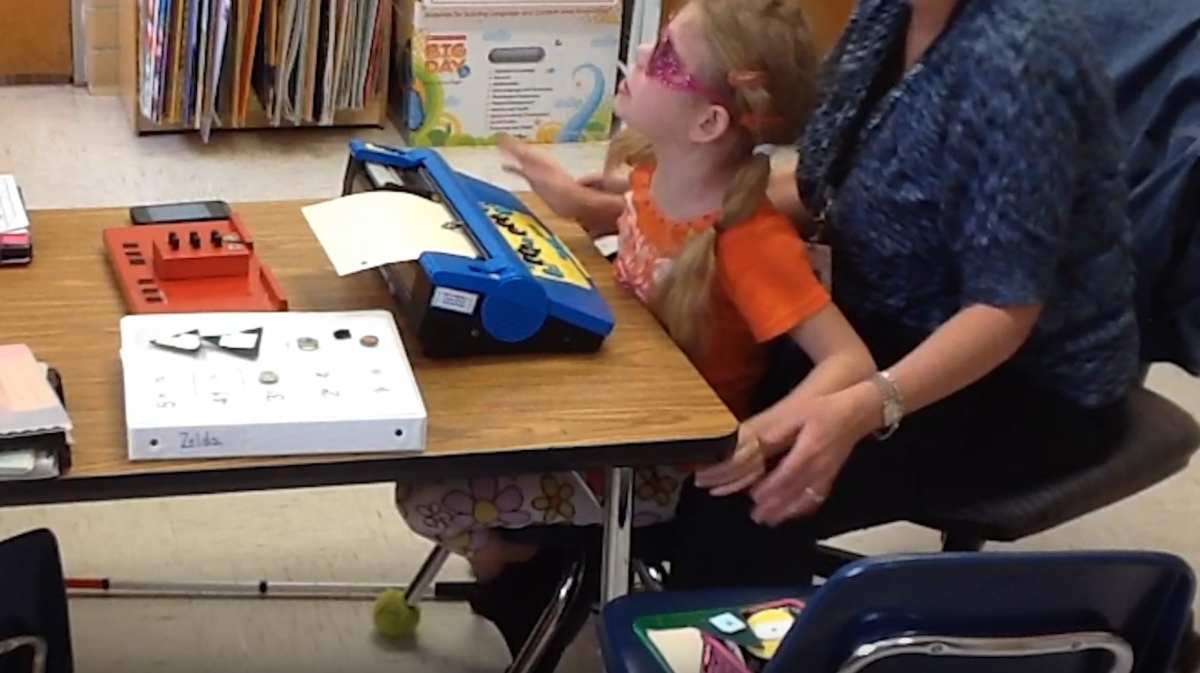
Gail (mother): It took a while, and Holly never gave up on figuring out the best learning process for Zelda.
Introducing Simple Books with Tactile Symbols
Holly (TVI): In second grade, we introduced tactile symbols. And I started with really simple books that just had one symbol. Like this is a book about her class. “I’m in second grade, I’m in Ms. Ross’ class,” and this (paperclip) is a symbol for class.
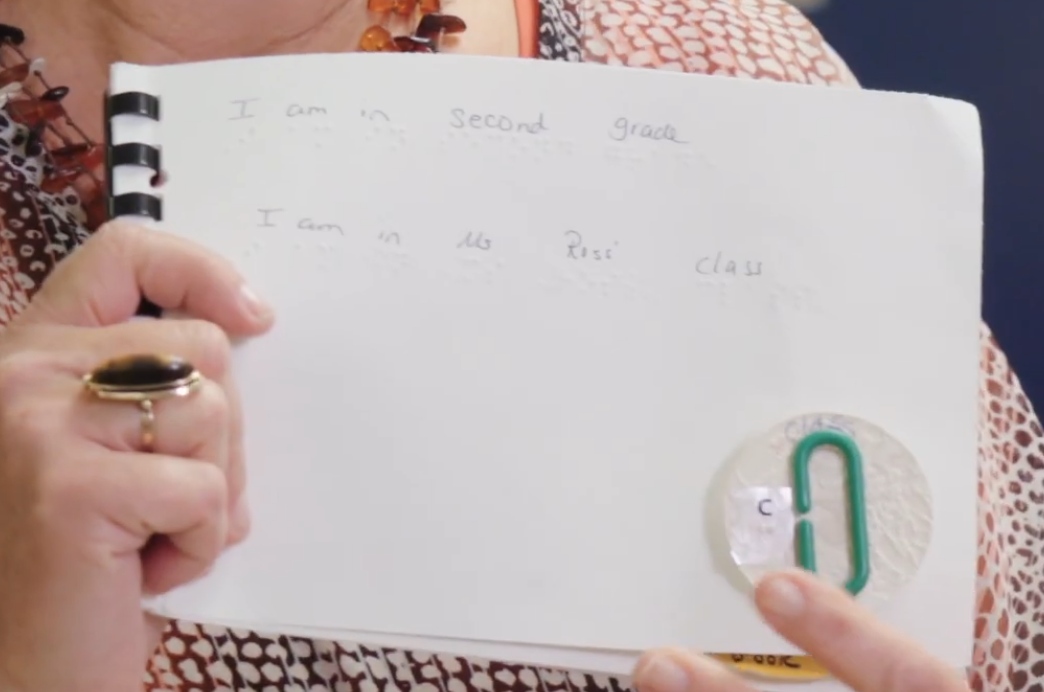
And then it talked about her liking to read books. So there’s this symbol for book. But the braille is always here, that’s key. Yeah, I always kept the braille there and I always showed her what the braille was. Never gave up on it. Symbol for math.
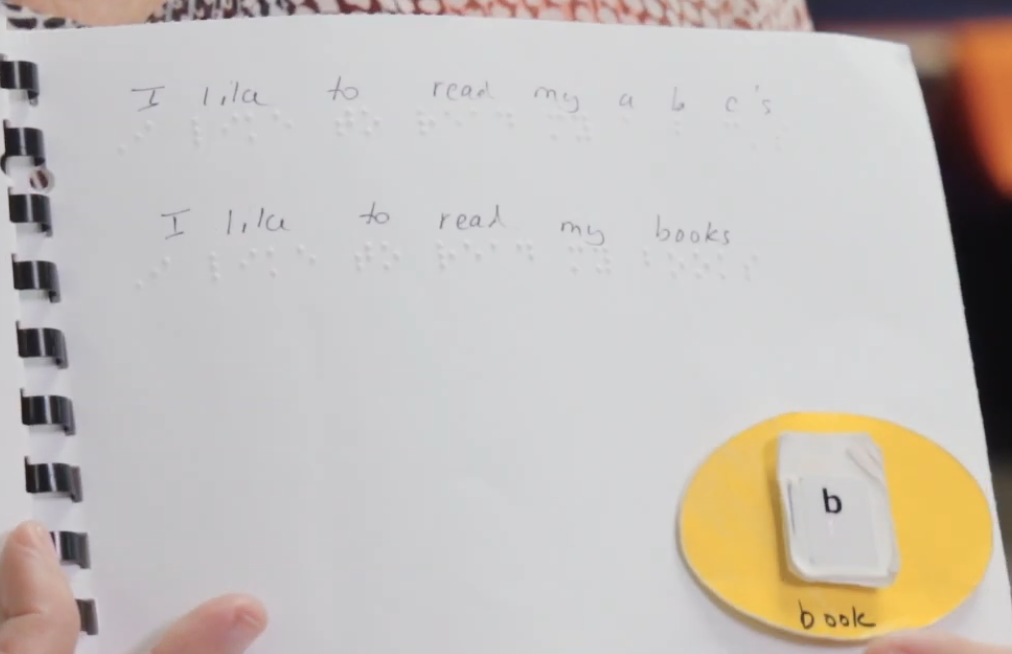
And then she was able to take these books into her classroom and she was able to read with her peers. She loved animals, so I did a lot of books with animals. I was thinking, “what does she like?” And I was always pairing what she liked with the materials. That way I could engage her and getting her attention.
Sara (O & M): Working with Holly and working to get social stories of when she was feeling anxious, and there’s a social story to explain that helped her work through her emotions, and helped her to process her information and move forward.
Holly (TVI): By the end of second grade, I set a goal for her to learn a hundred tactile symbols and Zelda mastered a hundred and fifty. They were just in her life, they were everywhere, they were on her schedule, they were in her P.E. class, in her books.
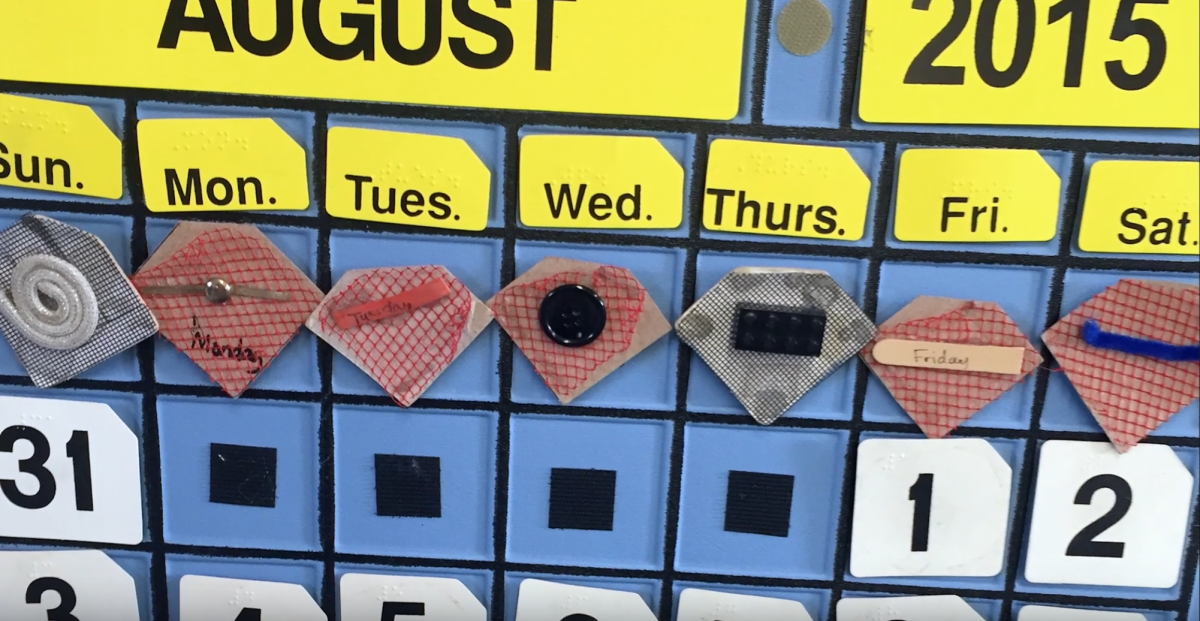
They were part of her behavior plan, and it was hugely successful.
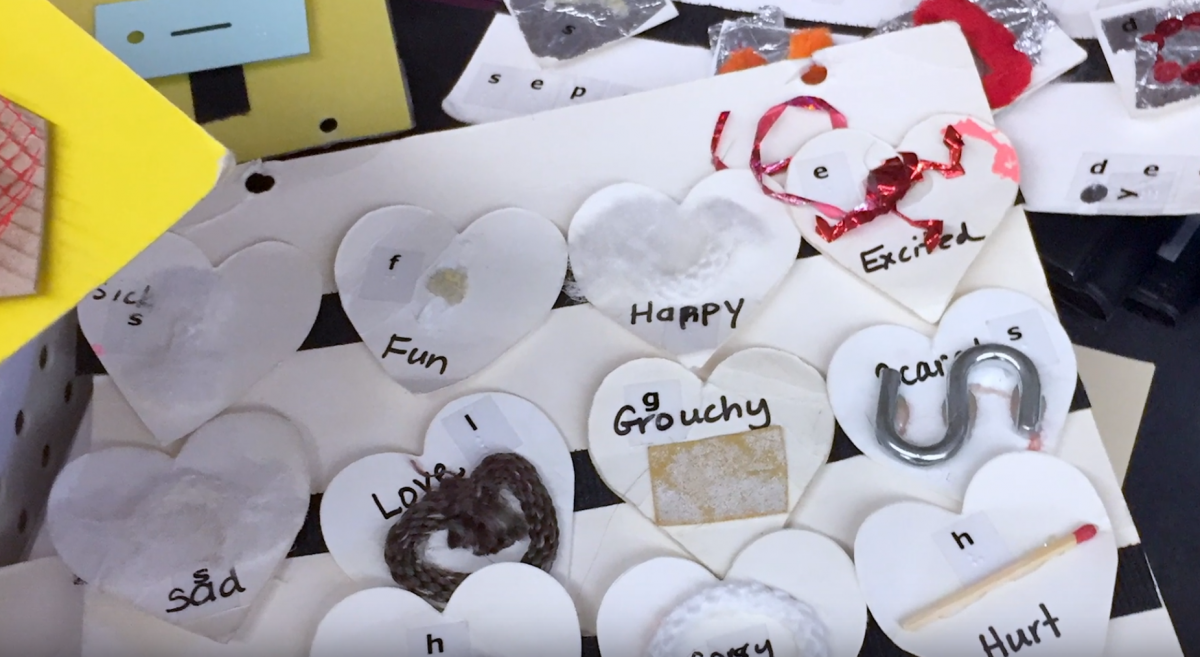
Learning Functional Braille
Holly (TVI): When we got to third grade I thought, “Well, now it’s time to start learning more functional braille.” It was a good transition, I just slowly started taking the symbols away. We would read books without tactile symbols, and we would transition to books like “Hop on Pop”, for example. I used a lot of Dr. Seuss, a lot of sing-songy music books. And then she was tracking and listening. So she was reading and listening. From there, we just expanded into– She was reading functional braille, she was reading sight words. Her family’s name, her friend’s names, my name. Places that she was going, her classes.
Sara (O & M): With Zelda and literacy, it opened up her world. She was able to read braille signs, she was able to read braille lists, so when we went to the grocery store, she was able to read the list and she knew what she had to find. Now that we’re riding the city bus, reading the braille signs is a huge thing for her.
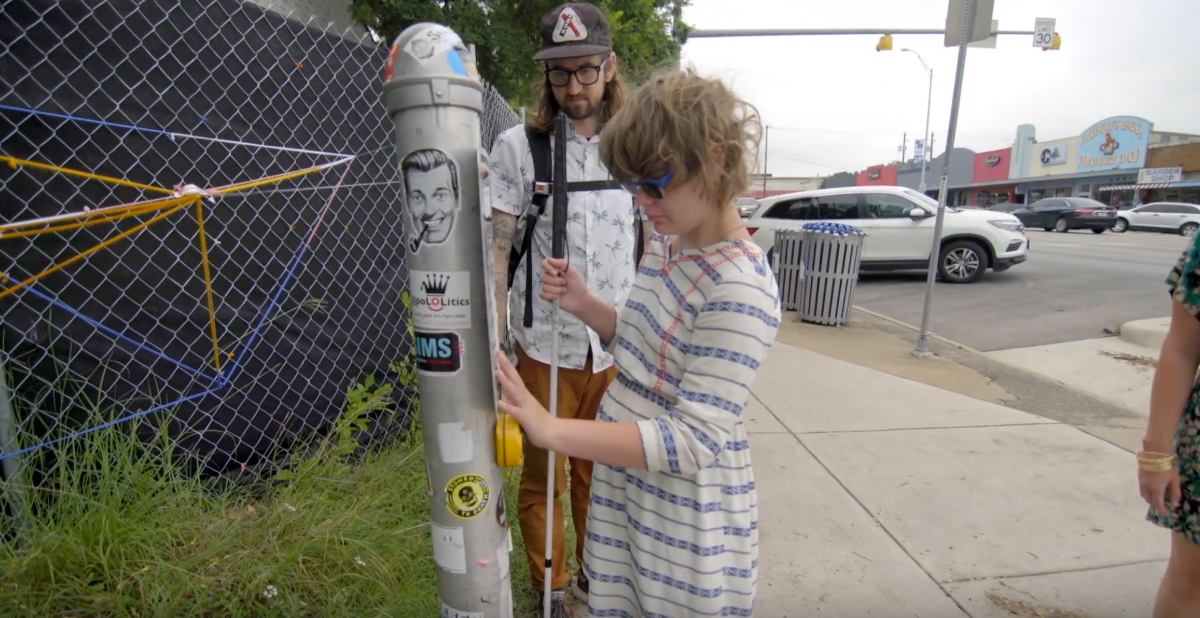
A Sponge for Literacy
Holly (TVI): She quickly went to the braille, quickly gained those functional words, those basic sight words, and we put those into books, and she was reading those successfully. They were doing double-spaced lines, then we moved braille to single-spaced lines and she quickly got that. This year we’re in seventh grade, she’s reading fluently, she’s reading “the Cay”, she’s reading “Charlie and the Chocolate Factory”. She read “Oliver Twist” and loved that this year. Just a sponge for literacy.
Gail (mother): Anyone that would go into this profession of being a VI instructor working with the visually impaired pretty early on, is gonna figure out whether they’re cut out for it or not. It’s almost like co-parenting. I mean, it’s like you decide you wanna be with this child or the child decides on you… Or hopefully both. Yeah, and then you have to put up with those days of her slapping you, and saying the F-word, and saying “I hate you,” and then just roll with it, and just grow with it ’cause the growth is so amazing. That’s when I think it really is, it’s extraordinary.
Evan (father): You have to know that it’s gonna be tough some days. You’re looking at a very difficult challenge, but one that can be done as we are seeing. Born out in our family.
Holly (TVI): And here we are today, and I never dreamed that Zelda would read contracted braille. She has mastered almost sixty braille contractions.
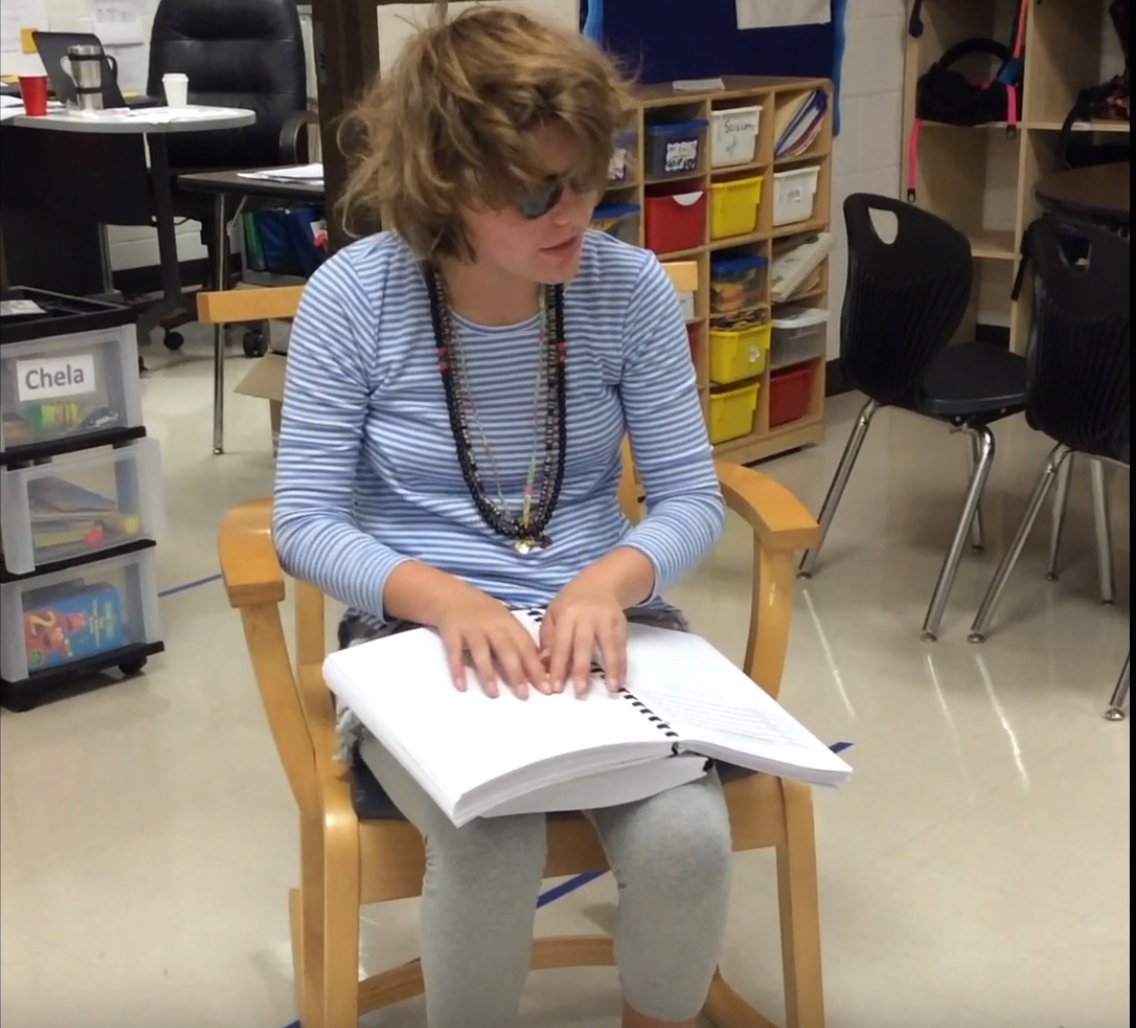
I told her mom early on, “I don’t know if we’re gonna get to contracted braille. That’s my ultimate goal, to get her there.” It’s so difficult to learn contractions, and I’m so proud of her.
Gail (mother): Now, she comes home and she takes out her books and she reads. She listens to her iPad with one hand, and she reads braille with the other hand.
Evan (father): She takes her books everywhere. When she goes to sleep, she takes a stack of four braille books, minimum. Up into bed with her, and she lays them down. They never slide away, like a teddy bear, almost.
Alberto (Assistant Principal): Seeing Zelda out in the community, utilizing those life skill lessons is one of those things that you get to experience and see their growth on an everyday basis.
Evan (father): Zelda now asked me, “Daddy, what’s high school?” I don’t know that I would’ve answered that question before.
Gail (mother): The future I would…I don’t know. People ask that, and I feel like she’s on this learning curve that is just really going faster and faster every day. She’s learning more and more and Holly just pushes her everyday. So much, we have so many books. They’re really thick, and Zelda goes to sleep with them every night.
Holly (TVI): She’s a great reader. The world is open to her. She’s got the skills to do great things. And I’m on that journey with her, to get her where she needs to go.
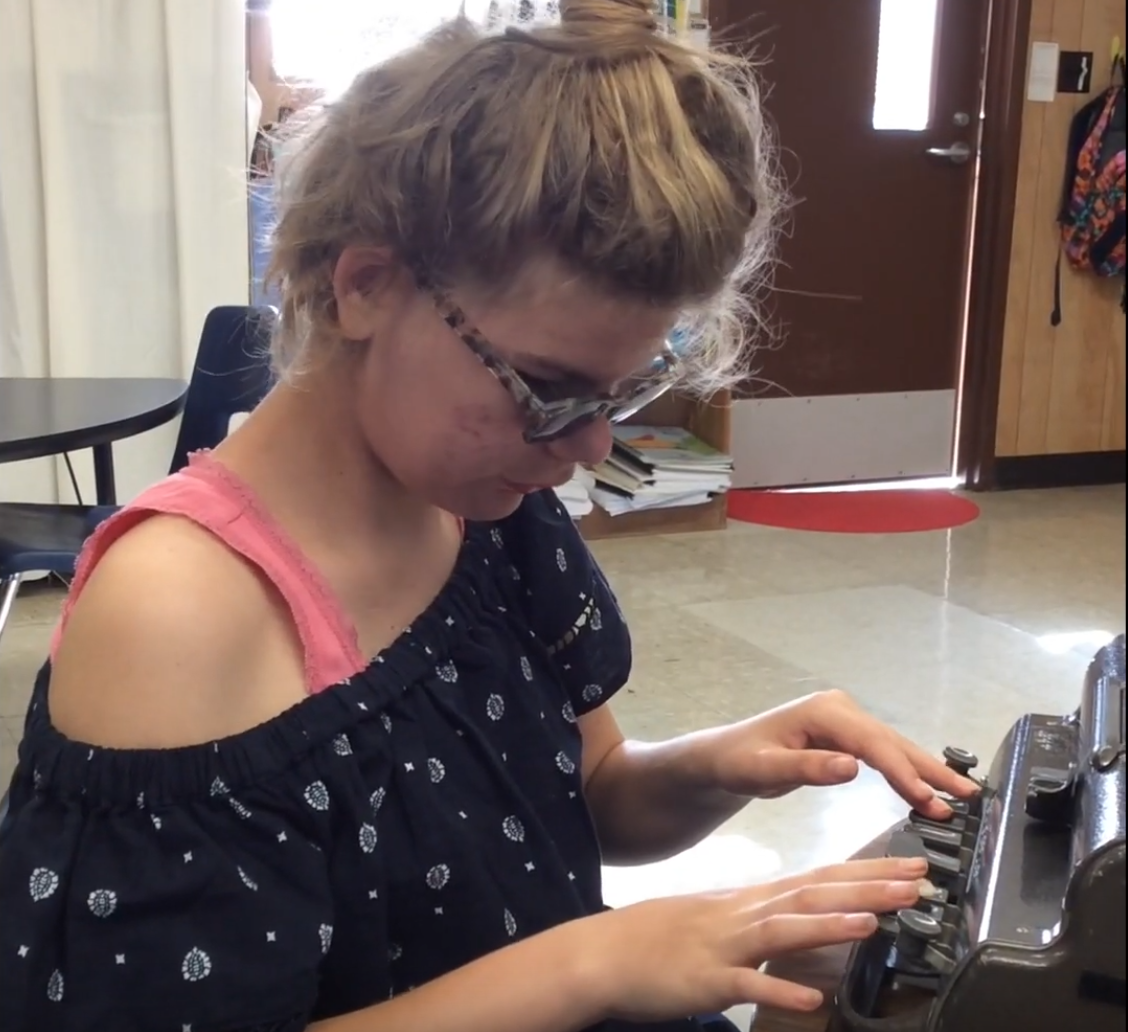
Watch this related video to learn more about the instructional strategies used.
1st Grade: Building Trust:
- Calendar system using object symbols
- Developing routines
- Learning to anticipate what will happen next
- Do one activity and then have a break; slowly lengthening the amount of time she would sit to do an activity
- Following her learning style with preference for auditory
- Dr. Suess (e.g. Hop on Pop) or Eric Carle, The Very Hungry Caterpillar, for sing-song quality and rhyme; this helped to develop her ability to track braille while listening to the story being read on YouTube videos
2nd Grade: Learning Tactual Symbols
- Adapted Dual Vision books with tactual symbol and spaces between braille letters
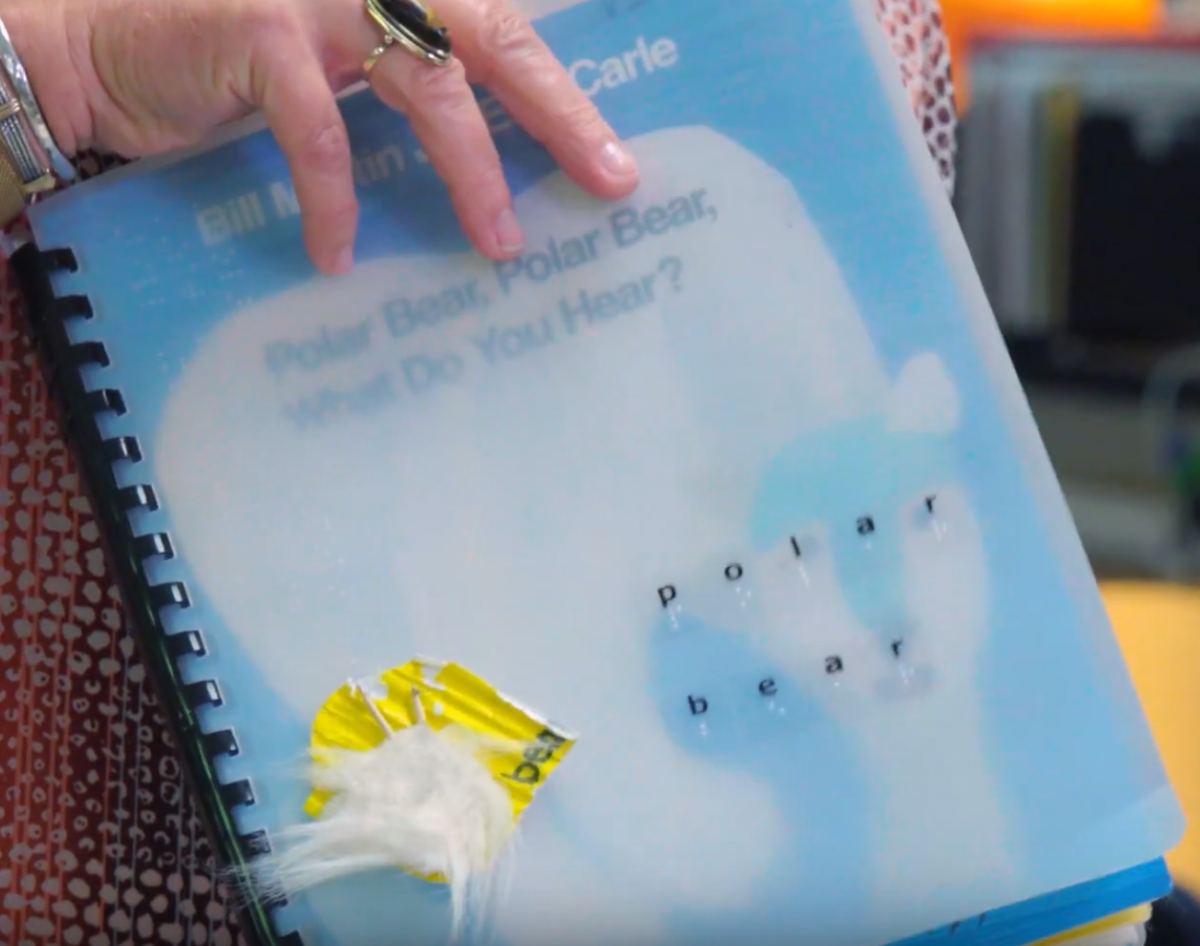
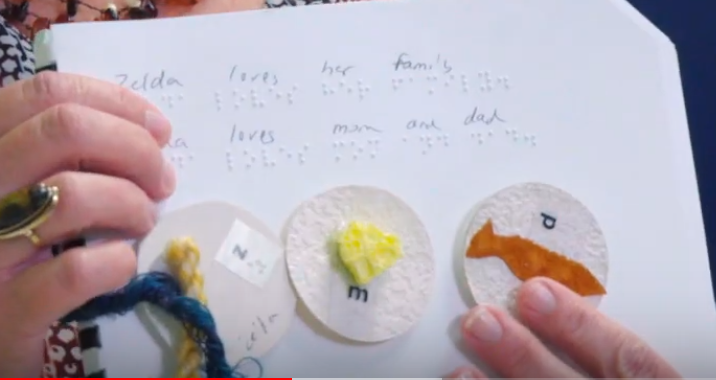
3rd-6th Grade: Functional Braille
- Slowly started taking the symbols away
- Emphasized the auditory component, using the Franklin Pen (auditory pen)
- Reading sight words (her name, teacher’s name, family’s names)
- Created books using those sight words, paired with the auditory at first, then slowly taking that away
7th Grade: Braille Contractions
